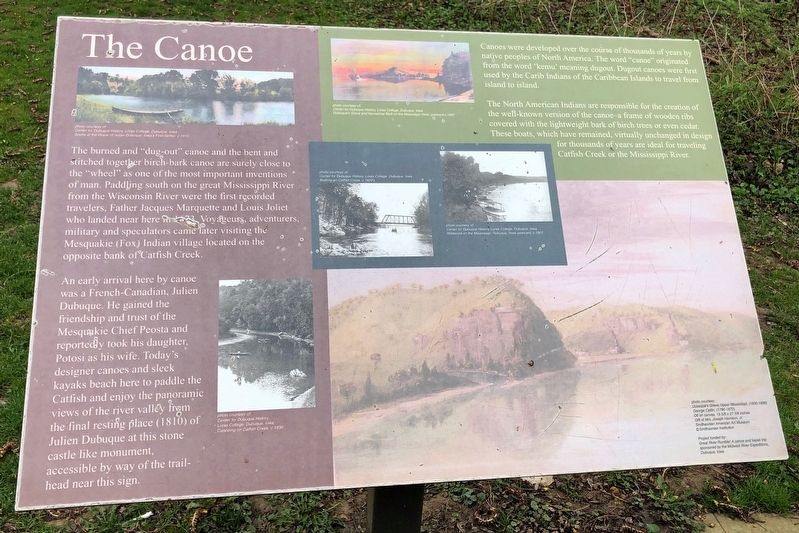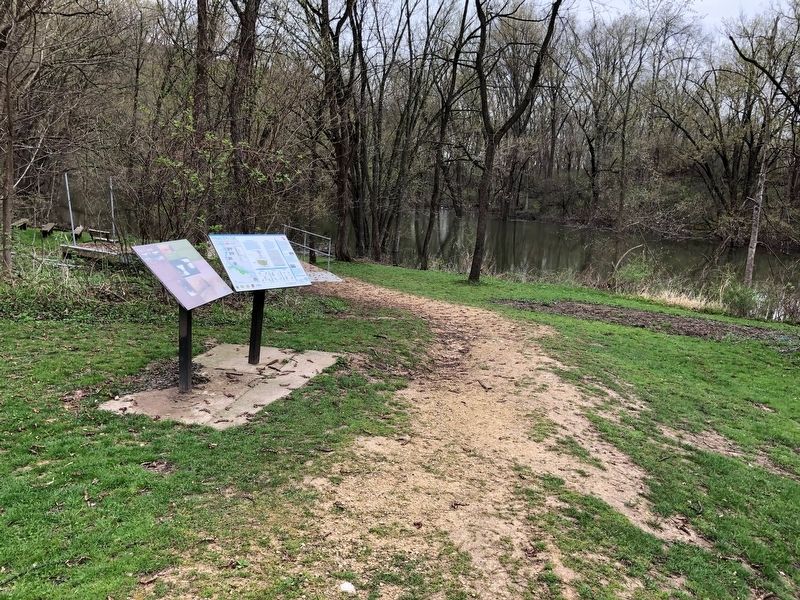Dubuque in Dubuque County, Iowa — The American Midwest (Upper Plains)
The Canoe
The burned and "dug-out" canoe and the bent and stitched together birch-bark canoe are surely close to the "wheel" as one of the most important inventions of man. Paddling south of the great Mississippi River from the Wisconsin River were the first recorded travelers, Father Jacques Marquette and Louis Joliet who landed near here in 1673. Voyageurs, adventurers, military and speculators came later visiting the Mesquakie (Fox) Indian village located on the opposite bank of Catfish Creek.
An early arrival here by canoe was a French-Canadian, Julien Dubuque. He gained the friendship and trust of the Mesquakie Chief Peosta and reportedly took his daughter Potosi as his wife. Today's designer canoes and sleek kayaks beach here to paddle the Catfish and enjoy the panoramic views of the river valley from the final resting place (1810) of Julien Dubuque at this stone castle like monument, accessible by way of the trailhead near this sign.
Canoes were developed over the course of thousands of years by native peoples of North America. The word "canoe" originated from the word "Kemu" meaning dugout. Dugout canoes were first used by the Carib Indians of the Caribbean Islands to travel from island to island.
The North American Indians are responsible for the creation of the well-know version of the canoe-a frame of wooden ribs covered with the lightweight bark of birch trees or even cedar. These boats, which have remained, virtually unchanged in design for thousands of ears are ideal for traveling Catfish Creek or the Mississippi River.
Erected by Great River Rumble! A canoe and kayak trip sponsored by the Midwest River Expeditions, Dubuque, Iowa.
Topics. This historical marker is listed in these topic lists: Native Americans • Waterways & Vessels. A significant historical year for this entry is 1673.
Location. 42° 28.001′ N, 90° 38.887′ W. Marker is in Dubuque, Iowa, in Dubuque County. Marker is on Mines of Spain Road, 0.3 miles east of Monument Drive. Touch for map. Marker is in this post office area: Dubuque IA 52003, United States of America. Touch for directions.
Other nearby markers. At least 8 other markers are within 2 miles of this marker, measured as the crow flies. Historic Dubuque (about 800 feet away, measured in a direct line); The Native Americans at the Mines of Spain (approx. 0.2 miles away); Julien Dubuque and the Mines of Spain (approx. 0.2 miles away); Julien Dubuque (approx. 0.2 miles away); Dubuque's Mines of Spain / New Melleray Abbey (approx. half a mile away); Dubuque's Mines of Spain / Historic Dubuque (approx. one mile away); East Dubuque Veterans' Memorial (approx. 1.8 miles away in Illinois); Eleazor and Diadamia Frentress (approx. 1.8 miles away in Illinois). Touch for a list and map of all markers in Dubuque.
Credits. This page was last revised on May 5, 2019. It was originally submitted on May 4, 2019, by Ruth VanSteenwyk of Aberdeen, South Dakota. This page has been viewed 284 times since then and 17 times this year. Photos: 1, 2. submitted on May 4, 2019, by Ruth VanSteenwyk of Aberdeen, South Dakota. • Andrew Ruppenstein was the editor who published this page.

